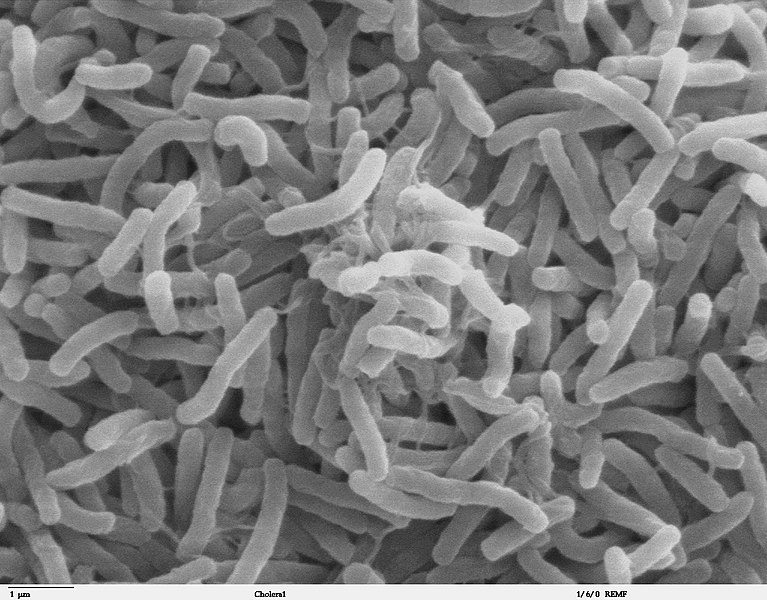Earth Watch Report - Biological Hazards

Scanning electron microscope image of Vibrio cholerae bacteria, which infect the digestive system.
Zeiss DSM 962 SEM
T.J.
Kirn, M.J. Lafferty, C.M.P Sandoe and R.K. Taylor, 2000, "Delineation
of pilin domains required for bacterial association into microcolonies
and intestinal colonization", Molecular Microbiology, Vol. 35(4):896-910
Ronald Taylor, Tom Kirn, Louisa Howard
Source:
http://remf.dartmouth.edu/images/bacteriaSEM/source/1.html
Wikimedia.org
.....
.....
RSOE EDIS
|
|
| Description |
| Sample
test of stool of patients thought to be suffering from diarrhea in
Rautahat district has confirmed the disease to be deadly cholera
instead. After the District Health Office failed to do anything about
the fast spreading problem in the region, a special team of doctors had
been deployed to identify the illness. National Public Health Laboratory
has confirmed the disease as cholera. People had started to fall sick
with the symptoms of diarrhea since the past four weeks in Gaidatar
village of Rautahat. A team of four doctors led by Dr Pranil Man Singh
Pradhan had taken stool sample of the patients three weeks ago, result
of which was revealed on Thursday. The team was deployed by the
Epidemiology and Disease Control Division and Patan Health- Science
Academy. According to Dr Subash Chaudhary of the District Health Office,
doctors had taken stool of seven people for sample test. "It has been
confirmed that that was not diarrhea but cholera," he said. In the
village, 435 people have been complaining about gastroenteritis
complications over the recent weeks. Govinda Timilsina, operator of a
local 'Timilsina Clinic' in Rautahat said that the disease in spreading
fast despite efforts made to control it. "Ten new patients were added
only on Thursday," he said. On Thursday, Maya Bal, Kajiman Waiba and
Rakesh Kachhadiya, among others were given saline drip and few have been
provided with medicine, Timilsina informed. Last time, cholera was
detected in the village five years ago, and it has claimed life of two
and affected over hundred people. Locals are enraged that the government
has not taken it much seriously even when over 400 people have already
been affected this time. Moreover, a government team led by Duryadhan
Chandra Banshi, which was sent out for inspection of the situation has
earlier reported that the disease is already coming under control.
According to Chaudhary, contaminated drinking water is the foremost
reason for the spread of the deadly disease. "The drying up of rivers
and destruction of Chure ecosystem have contributed to the pollution and
unhealthy environment," he added. |
| Biohazard name: | Cholera Outbreak |
| Biohazard level: | 2/4 Medium |
| Biohazard desc.: | Bacteria and viruses that cause only mild disease to humans, or are difficult to contract via aerosol in a lab setting, such as hepatitis A, B, and C, influenza A, Lyme disease, salmonella, mumps, measles, scrapie, dengue fever, and HIV.
"Routine diagnostic work with clinical specimens can be done safely at
Biosafety Level 2, using Biosafety Level 2 practices and procedures.
Research work (including co-cultivation, virus replication studies, or
manipulations involving concentrated virus) can be done in a BSL-2 (P2)
facility, using BSL-3 practices and procedures. Virus production
activities, including virus concentrations, require a BSL-3 (P3)
facility and use of BSL-3 practices and procedures", see Recommended
Biosafety Levels for Infectious Agents. |
| Symptoms: | |
| Status: | confirmed |
|
|
.....
Cholera Claims one life in Rautahat, dozens affected
Diarrhoea claims one in Rautahat
Added At: 2014-05-19 8:44 AM
Last Updated At: 2014-05-19 10:49 AM
 THT Online/File
THT Online/File
In this file photo a diarrhoea patient is undergoing treatment at Chandranigahapur Hospital, Rautahat.
PRABHAT KUMAR JHA
RAUTAHAT: Diarrhea claimed life of a child at Gaidatar VDC here on Sunday.
The
deceased has been identified as Mohisang Maya Sitan. Mohisang who was
suffering from diarrhea died as she could not get proper medical
treatment, her family members said.
Read More Here
.....
.....
